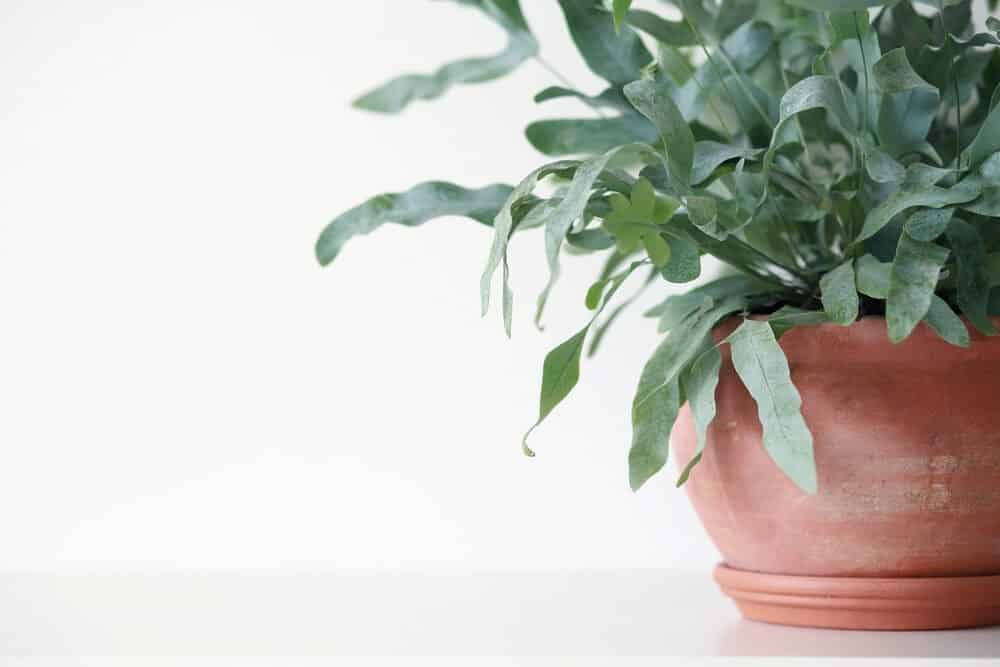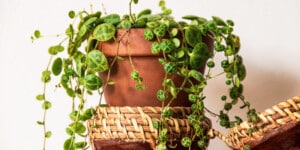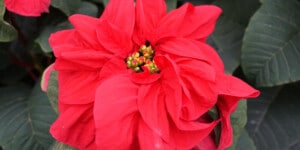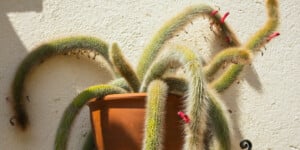If you want a cute and hardy plant to decorate the tables and desks of your home, then you have found the right plant!
The blue star fern is small and cute and grows wildly. But it’s care and management might be out of a beginner gardener’s level, because this plant grows on other plants!
Blue Star Fern Care & Growing Guide
1. Light requirements
Blue star ferns like to grow in bright but indirect sunlight. If it is exposed to intense amounts of direct light, its leaves will wither and droop. One of two hours of morning light is ok, but it should be away from the sun’s rays by the time noon comes around.
2. Water
You need to keep this plant very moist. It likes a lot of humidity in the air since it originates from South American tropical forests. If your home is dry but sure to mist the plant often with a spray bottle or you can set it next to a humidifier.
3. Climate and temperatures
Room temperature, around 72 degrees, is good enough for this plant. If you can keep it in a warmer room, then that would be ideal. Warmth and humidity are significant survival factors for this plant. If you own a small greenhouse tower that can be placed in your home, this would be the best way to help the blue star fern thrive and live a long life. Don’t let the temperature in the home or greenhouse drop below 50f. If you do, then the leaves of the plant will cause its leaves to curl.
4. Soil
Acidic soil, around 5.5. to 6.5, is the best type of soil for this plant. The soil must drain well and quickly, to prevent waterlogging the roots. If you need soil that drains faster, you can add perlite to your potting soil to improve drainage. The soil has to remain moist always, and don’t allow it to dry out. But don’t soak it, especially around the roots. You can include rocks at the bottom of the container for even more drainage.

5. Repotting
Only repot this plant when its roots are coming out of the drainage holes. When you choose a container, you can use a large or small one. If the soil drains quickly, the size of the pot doesn’t matter. When you repot the blue start fern, you may want to cut off any baby plants growing from the root ball and propagate them. Repot this plant in the early spring with fresh soil to encourage more growth.
6. Height and spread
Usually, the blue star ferns grow to about one foot in both length and height. This plant has shallow roots, so it grows out instead of up. If it has enough room, this plant will slowly start to cover the ground area as its baby plant grow up and spread.
7. Trimming
Trim ferns in the early spring before there is new growth or after the new growth have arrived. Cut off dead or dying leaves and stems. You can also remove stems that are very long and take up a lot of nutrition and energy. If you do this, the fern can devote more of its resources to the smaller stems.
How to propagate the blue star fern?
Yes, this plant can be propagated if you remove one of the tubers or rhizomes and replant it into another pot. Around the sides of the main plant, small offset leaves will grow. These are the rhizomes that you can dig out from the soil. You will have to the offset plant from the main plant, but neither plant will suffer adverse effects. The rooting system for ferns is shallow, so don’t bury the new plant too deep, just enough to cover the roots.
Does this plant have flowers, and how do I help them bloom?
No, the blue star fern does not produce any flowers or flower bulbs.
Is the plant poisonous?
No, this plant is not toxic to either humans or cats and dogs. It is not an edible plant, though.
Can the Blue Star Fern grow in water?
No, this plant cannot grow in water or swamps or wetlands. The soil of this plant must stay moist, but too much water will suffocate and kill the roots.
Common Plant Diseases and pests
Fern scales are small insects that suck out sap from ferns, which destroys their stems and kills leaves. They must be disposed of quickly before they multiple and kill the fern. If their numbers are low, pick them off by hand and then spray a neem oil spray on the plant to keep them away. If there are many, then you should scrape away all destroyed plant parts and the spray Isopropyl alcohol directly on the insects. Do this outside because these insects will run away and scatter.
Leaf drop occurs in this plant when it’s not exposed to enough bright indirect light. The colors of its leaves will fade first, and then the leaves fall off a few days later. Always keep this plant in front of a large window or on a porch. Morning light will also prevent leaf drop from occurring.
Root rot is a prevalent disease for this plant. Because the soil must always stay moist, it’s easy to overwater it. You will see root rot appear on the blue star fern when the bottom of the plant starts to become discolored and turn brown. To fight root rot, you must completely replace the soil around the plant and repot it in new soil. Root rot lives in the soil, so throw the old dirt in the trash; do not use it on your other plants.
Conclusion
- This plant mostly lives in South American forests
- Hardiness zones 9 and 10 are the best zones for this plant.
- You can propagate this plant by cutting baby leaves with roots coming out from the soil and replanting them.
- Humidity is a major factor for the blue star fern’s wellbeing.
- Direct sunlight will dry its leaves.
- Always keep the soil moist. Don’t let it dry out.
Keep reading: Dwarf Ixora: Plant Care & Growing Guide
Victoria is the owner and main author of hobby plants. She loves spending her free time in her garden planting and taking care of her plants. Victoria hopes you enjoy the content here!
![Mother Of Thousands Plant [Complete Plant Care Guide] Mother Of Thousands Plant [Complete Plant Care Guide]](https://www.hobbyplants.com/wp-content/uploads/2022/07/mother-of-thousands-plant-300x158.jpg)





![Majesty Palm Plant Care: [Complete Beginner's Guide] Majesty Palm Plant Care: [Complete Beginner's Guide]](https://www.hobbyplants.com/wp-content/uploads/2022/08/majesty-palm-care-300x158.jpg)
![Exotic Angel Plant Care: [Complete Beginner's Guide] Exotic Angel Plant Care: [Complete Beginner's Guide]](https://www.hobbyplants.com/wp-content/uploads/2022/08/exotic-angel-plant-care-300x158.jpg)
![Snow White Waffle Plant: [Complete Care Guide] Snow White Waffle Plant: [Complete Care Guide]](https://www.hobbyplants.com/wp-content/uploads/2022/08/snow-white-waffle-plant-300x158.jpg)
![Waffle Plant Care: [Complete Beginner's Guide] Waffle Plant Care: [Complete Beginner's Guide]](https://www.hobbyplants.com/wp-content/uploads/2022/08/waffle-plant-300x158.jpg)
![Bird Of Paradise Plant Care: [Complete Beginner's Guide] Bird Of Paradise Plant Care: [Complete Beginner's Guide]](https://www.hobbyplants.com/wp-content/uploads/2022/08/bird-of-paradise-plant-300x158.jpg)
![Purple Passion Plant Care: [Complete Beginner's Guide] Purple Passion Plant Care: [Complete Beginner's Guide]](https://www.hobbyplants.com/wp-content/uploads/2022/08/purple-passion-plant-care-300x158.jpg)
